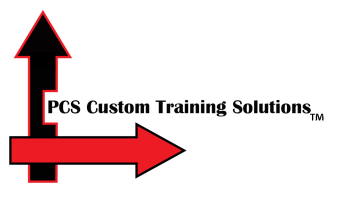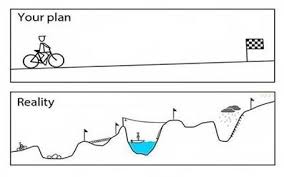It’s Small Business Week this week.
Last month was the seven-year anniversary of incorporating PCS Custom Training Solutions LLC. If you are curious about the PCS origin story, it’s here: https://pcscustomtraining.com/wp/safety-elearning-when-is-the-juice-worth-the-squeeze/
I do most of my rumination on blog topics while doing semi-mindless tasks: applying milk paint to wood trim for a project in the barn, weeding the perennial garden, hiking with the dog, mowing the horse pastures, and driving hither and thither, which I’ve done a lot recently. I’ve been busy in the “soup of doing” and haven’t blogged in a hot minute, so here we are.
I was going to call this blog “The Seven Year Itch of Entrepreneurship” but that sounded like something involving a rash or a failed marriage, so I went with Plan B.
The statistics on small businesses are a bit disheartening:
- Only 78.5% of small businesses survive their first year.
- Business owners under 30 years of age are more likely to fail.
- The most common reason small businesses fail is that the market simply doesn’t need their products or services.
- 29% of businesses fail because they run out of cash.
[Source: Fortunly.com]
My last intention is to suggest that I have it all figured out or that we couldn’t fail this year, or next. In fact, in the featured image you may recognize me as the little figure adrift in a small boat. But I figured if I save someone else a little suffering by sharing my own, it’s worth the time spent both introspectively and at the keyboard.
In no particular order, here’s some of the sometimes cringe-worthy schooling I’ve experienced:
The Concept of Good Enough and Pouncing On Problems
I am, by my very nature, a fixer. It has been the reason for my success, and I’m convinced that all entrepreneurs are in the business of fixing problems.
In short, my clients have a how-do-we-provide-great-eLearning-when-we-don’t-have-time-but-we-do-have-high-standards problem. We have perfected the fix.
Being a fixer does not come without an insidious (and annoying) dark side. I pounce on problems. I want to fix them all. I want to do it Right Now. I want everyone to share my sense of urgency. And in the end, I want it to be perfect. As in flawless, as in standing ovation spectacular, Nadia Comaneci sticking-the-landing.

For you youngsters, Nadia Comaneci scored a perfect 10 in the 1976 Olympics. (I was young then. You were not born yet. Sigh.)
But here’s the reality. Oftentimes, “good enough” is just that. I tell my team that I have a flawed ‘good enough meter’ and rely on them to help me calibrate my judgment on such matters. They have gotten really good at jumping in early on this and speaking up, and I’ve gotten better at asking.
The sister-problem to being a fixer is being a pouncer as well. A problem arises and I almost literally have to sit on my fingers to not react, to let the processes and people assigned to handle the problem, well, handle it. I actually have a note posted in my office that says “DON’T POUNCE!”
My friend, Bri, the owner of an equine veterinarian practice in Canada, described this same lesson with a far more positive spin:
“Embrace the Pause”
So much magically happens during the pause. Or as Brené Brown said in 2021 about her own anxiety:
“There are two questions that I always ask myself and they become default in times of high anxiety,” she says. “One is, ‘Do I have enough data to freak out? ‘ and the second one is, ‘Will freaking out help even if I have enough data? ‘ – I rarely have enough data to freak out.”
Sometimes, when you embrace the pause, the problem actually resolves itself.
I Am Often “The Bad Idea Fairy”
This is related to the first lesson but not quite the same.
I first heard the term Bad Idea Fairy from my friend Aarene Storms in her wonderful book Endurance 101, and it resonates with me. (Thanks, Aarene!)
What is a Bad Idea Fairy?
The origin of the term is in the U.S. military and describes an evil, mythical creature that whispers advice and ideas into the ears of leadership, causing hundreds of unnecessary changes and countless wasted man-hours.
[Source: Engineering Management Institute]
In 2019 and 2020 when I was entirely re-organizing the company and taking it from a chaotically-directionless-and-suffering-tech-issues-but-somehow-making-it venture to a well-oiled machine (at least in my head) I had ideas. A lot of them. Instinctively, I knew how the business should run. I did a lot of reading and audio-book listening. I was running on a lot of adrenaline and not a lot of sleep. I had a lot going on in my personal life and allowing PCS to struggle, or heaven forbid, fail, was Not Okay.
So I emailed my team. A lot. Often at night or at 5am when I was fully caffeinated and just chock-full of notions and suggestions and tweaks and big-picture philosophies and draft emails I might send. One might call it enthusiastic or passionate. But objectively, it had to be annoying as hell.
My team rebelled. At the time we had started PCS Team Happy Hours and I’d open it to feedback —
“What could we be doing better?”
It was that question and typically the happy hour environment that got us to all of the grown-up communication and file/document storage systems that we use today. Their patience (mostly) was extraordinary. The team spoon fed it one software program/system at a time, and I –sometimes with a display of techno-ineptness that I suspect they found some mix of charming and pathetic– I eventually got better at the how and when of sharing my (often misguided) brilliance.
I still sometimes send Slack messages at 4:48am on a Sunday but I’ve made it clear to the whole team that they should turn off their notifications and not dare respond to me off-hours, as that’s not a part of the gig. If I send a text from the road, well yep, then something time-sensitive is happening.
I want to defend myself by saying that I do occasionally have Good Ideas too.
It’s All About The People
This lesson has been a game-changer.
With regard to my clients, I’ve been made wildly aware during Covid and after a move several states from my original home, that seeing your clients face to face is priceless. Discussing problems and solutions, catching a vibe that is unspoken but as obvious as rolled eyes or a dismissive head shake, those things just can’t be caught on Zoom or via email, or even a phone call.
This has meant I sometimes drive 20 hours for a two-hour meeting. But those have always been worth the mileage.
Over the years, the PCS team has changed. The ways I’ve found the people who have ‘done the work’ has been some or all of the above: serendipitous, karmic, based on long-time relationships, or in one notable case, based on a random Google search. Some have made it for the (relative) long haul; others have moved on to new ventures. All have contributed to the business.
It cannot be without challenges to work for a woman like me, although I like to think I’m pretty upfront about what one should expect to survive and thrive at PCS.
Despite all of the above foibles (and a dozen or so others) I believe strongly in: paying my team and vendors on time regardless of what’s going on with the clients or the business, letting the team set its own anticipated timelines for projects/tasks, protecting their time and work/life balance when it comes to sometimes demanding clients, and working on solutions when we run up against problems. No one steps in it with more frequency than me, so when I do or someone else does, we just apologize, pick up, dust off, ask how to keep it from happening again, and move on.
It’s All About The Processes
One of the early lessons I learned from Michael Gerber’s The E Myth: Why Most Small Businesses Fail (thanks, Lisanne, for the recommendation) is that my 20-some year old business, Proactive Compliance Services, was really just a way for me to be self-employed and earn a living while exhausting myself as a consultant and trainer.
For a business to earn money beyond the efforts of its owner, it needs to be designed to be sustainable without the owner’s involvement. That involves processes!
Like making a McDonald’s hamburger, the example cited repeatedly in the book, there is a formula for success. Repeatable, well-communicated, sustainable processes for building the product.

“It’s all about the hamburger” writes the broad who can’t recall the last time she ate at McD’s.
We have spent a ton of time and effort to document our processes, and one key member of our team is the gate keeper, catching us when we miss an improvement we identified casually but failed to document. Whether it is creating a course from scratch, or modifying an existing course for a new audience, evaluating LMS (learning management systems) for our clients, or transitioning clients from our old LMS to a new one, there’s a process for it, complete with checklists and testing to ensure quality control. McDonalds, eat your heart out!
It is ironic that in my safety consulting business, I have emphasized to clients for years that when they had safety issues, they were either people problems (rarely) or process problems (more frequently) and that a dual-pronged approach was going to be the key to permanently resolving that issue. (Anyone digging deep into root cause analysis will agree with this truth.)
I had to see it once again within my own business to have the lesson seared deeply into our company’s values.
Business Is An Infinite Game
I’m lousy at Sales, Marketing, Advertising and anything anyone would vaguely describe as a pithy Elevator Pitch.
I suspect this is because I’m pretty gifted at keeping clients around for a long time, twenty-some years in some cases.
When I read Simon Sinek’s book The Infinite Game I was giddy to hear that this is an actual business strategy! The idea is to treat your business as one that not only could need to evolve to meet the needs of your clients but one which must evolve in order to do so.
In a million ways, we do that every day, small and nimble as we are, re-solving new jigsaw puzzles and embracing problems as new opportunities.
$&*! Happens, So Keep Laughing
I’m not going to lie. I can curse like a Teamster driver, likely related to the quality time I spent working with hazardous waste drivers during my youthful career.
When something goes wrong, my heart rate spikes, my palms get sweaty and I am immediately in full-on Pounce mode with a side of Bad Idea Fairy sprinkled in.
The good news, and it is beyond good news –it is FUN!– is that if I embrace the pause, rely on the genius people with whom I work and the processes on which we rely, we typically get the problem resolved long before our clients are ever even aware of its existence.
Which is precisely why they continue to do business with us.
And as for me, my husband Tom just shakes his head when I talk about retiring and says — “No way, you’re never going to retire!”
The real secret to a fabulous life is to live imperfectly with great delight. (Leigh Standley)

